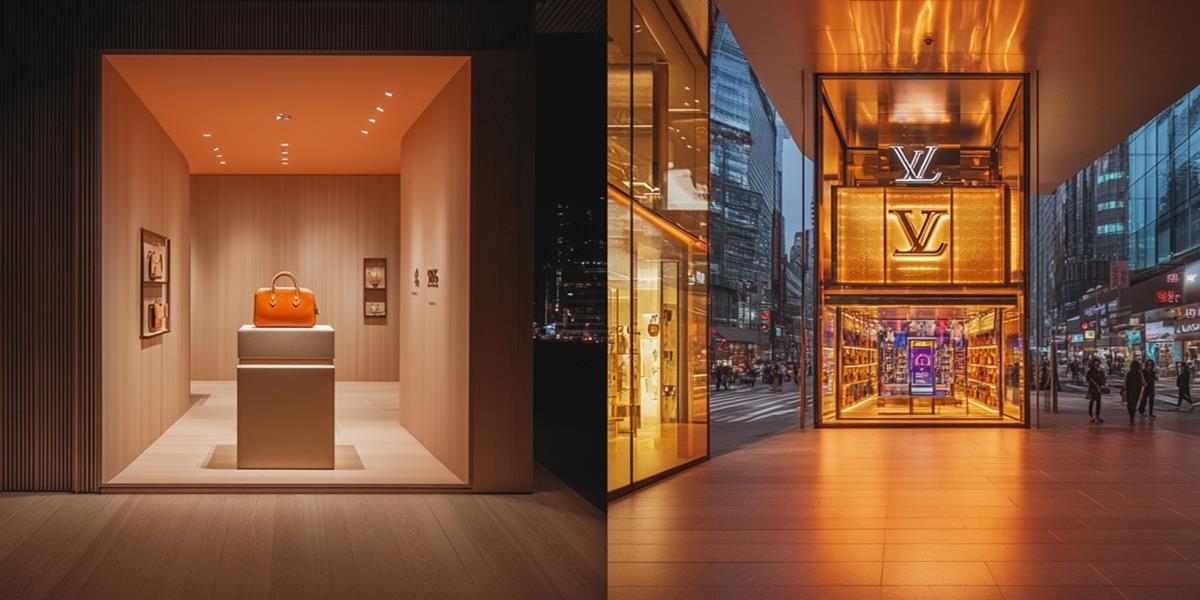Summary
Hermès has overtaken LVMH to become the world’s most valuable luxury company—a shift that reveals a deeper story about two radically different approaches to building a brand.While LVMH dominates through aggressive growth, acquisitions, and cultural relevance, Hermès has quietly focused on timeless craftsmanship, scarcity, and ultra-high-net-worth clientele.
This article breaks down the economic models, customer segmentation strategies, and time horizons behind each brand’s success, offering key lessons for businesses on long-term value, positioning, and the power of doing less—but doing it better.
This milestone is more than a headline. It marks a turning point in how value is created in the luxury sector. While LVMH built its empire on scale, diversification, and global dominance, Hermès has quietly played a different game: one of restraint, craftsmanship, and generational loyalty.
So, what are the economics behind this shift? And what can entrepreneurs, investors, and brand builders learn from these two titans of luxury? Let’s break it down.
Hermès: Artisanal Excellence and Relentless Scarcity
Hermès is the epitome of slow luxury. Founded in 1837 as a harness workshop, the brand has stayed true to its artisanal roots. Its strategy revolves around meticulous craftsmanship, limited production, and a laser focus on heritage.For instance, the legendary Birkin bag isn’t just a product; it’s a statement. With long waitlists and prices that can exceed six figures, the Birkin exemplifies Hermès’ deliberate scarcity model.
This scarcity is not a gimmick—it’s a carefully managed outcome of their production process. Bags are handcrafted by a single artisan, often requiring up to 48 hours to complete.
Key Economic Drivers
- Vertical Integration: Hermès owns its supply chain, from sourcing exotic leathers to employing skilled artisans. This ensures quality control and protects its brand integrity.
- Exclusivity: Limited production across product categories creates high demand and justifies premium pricing.
- Minimal Marketing: Hermès spends comparatively little on advertising, relying on word-of-mouth, prestige, and mystique to maintain its aura.
- Resale Value: Hermès products appreciate in value, particularly their iconic bags. This bolsters their reputation as investment pieces.
Financial Impact
Hermès has one of the highest margins in the luxury sector, with gross margins often exceeding 60%.Its tight control over production ensures inventory levels remain low, reducing the risk of overstocking or discounting—a common issue in the broader fashion industry.
LVMH: The Empire of Luxury
LVMH, on the other hand, is a diversified conglomerate comprising over 75 brands, from Louis Vuitton and Dior to Dom Pérignon and Bulgari. Founded by Bernard Arnault in 1987, LVMH’s strategy is centered on acquisition, diversification, and scale.While Hermès thrives on scarcity, LVMH operates on global ubiquity without diluting its luxury cachet. It achieves this balance by segmenting its brands: Louis Vuitton maintains ultra-premium exclusivity, while Sephora and Moët & Chandon target more accessible luxury markets.
Key Economic Drivers
- Acquisition Strategy: LVMH has grown by acquiring established luxury brands and rejuvenating them. Its portfolio diversification shields it from market-specific risks.
- Global Reach: With stores in nearly every major city, LVMH leverages global retail networks to capture a broad customer base.
- Marketing Powerhouse: LVMH is a marketing giant, with campaigns that blend traditional media and celebrity endorsements to maintain cultural relevance.
- Economies of Scale: As a conglomerate, LVMH benefits from shared resources, logistics, and operational efficiencies across its brands.
Financial Impact
LVMH’s scale and diversity make it a financial juggernaut. In 2023, it reported revenues exceeding €79 billion, dwarfing Hermès’ €13 billion.Its operating margins, while lower than Hermès, are still robust due to its efficiency in managing a vast portfolio.
Key Differences
| Aspect | Hermès | LVMH |
|---|---|---|
| Strategy | Artisanal craftsmanship, scarcity | Scale, acquisition, global ubiquity |
| Portfolio | Artisanal craftsmanship, scarcity | Scale, acquisition, global ubiquity |
| Strategy | Single-brand focus | Diversified across multiple sectors |
| Production | Handcrafted, limited supply | Mass luxury with tiered market appeal |
| Marketing | Minimal, relies on prestige | High investment in campaigns and events |
| Revenue Model | High margins, low volume | High volume, diversified margins |
| Growth Strategy | Organic, slow, deliberate | Aggressive acquisition and expansion |
Time Horizons: Long-Term Craftsmanship vs. Agile Growth
Hermès is playing the 100-year game. Every product, store opening, and artisan hire is made with the next generation in mind. Their motto might as well be: "If it takes time, it’s worth doing."LVMH, in contrast, operates with agility and speed. It spots trends fast, expands faster, and doesn’t hesitate to shake things up. This is the company that turned Louis Vuitton into a streetwear icon and partnered with Rihanna to redefine inclusivity in luxury.
Lesson: Both strategies can win—but only if they align with your values and business model. Are you building something timeless or something timely?
Customer Segmentation and Retention Strategies
Customer segmentation is at the heart of luxury brand strategy, and Hermès and LVMH approach this critical aspect of their business in strikingly different ways. While both brands cater to affluent clientele, their strategies for identifying, engaging, and retaining customers reflect distinct philosophies.Hermès: Catering to the Ultra-Elite
Hermès has built its empire on exclusivity, appealing primarily to ultra-high-net-worth individuals (UHNWIs) who value scarcity, tradition, and craftsmanship.- Selective Access
Hermès products, especially its iconic Birkin and Kelly bags, are deliberately hard to obtain. Long waitlists, in-store exclusivity, and personal relationships with sales associates create a sense of achievement and privilege for those who own Hermès items. - Personalized Customer Relationships
Hermès emphasizes building deep, personal connections with its customers. Frequent buyers often develop a rapport with specific sales associates, who curate recommendations and ensure a seamless shopping experience. - Generational Loyalty
Hermès positions itself as a brand that transcends generations. Many of its customers view Hermès products as heirlooms, reinforcing long-term loyalty within families. - Limited Engagement with Broader Audiences
Unlike LVMH, Hermès rarely seeks to attract aspirational buyers. Its strategy ensures that its brand remains aspirational for all but the wealthiest customers.
LVMH: Broad Appeal Across Market Tiers
LVMH adopts a more layered approach to customer segmentation, targeting both the ultra-wealthy and aspirational consumers.- Tiered Offerings
LVMH brands are segmented by price and exclusivity, allowing them to appeal to a wide range of customers. Louis Vuitton and Dior target high-net-worth individuals (HNWIs) with premium collections, while Sephora and Moët & Chandon offer entry-level luxury for aspirational buyers. - Cultural and Celebrity Influence
By collaborating with celebrities, influencers, and trendsetters, LVMH builds cultural relevance that attracts younger, aspirational consumers. Initiatives like Louis Vuitton’s collaboration with Supreme and Fenty’s inclusivity-driven campaigns resonate with diverse audiences. - Omnichannel Engagement
LVMH brands excel in creating an accessible luxury experience through flagship stores, digital platforms, and pop-up events. This omnichannel presence ensures that aspirational buyers can interact with the brand, even if they’re not making a purchase. - Retention Through Diversification
The breadth of LVMH’s portfolio allows it to retain customers as they evolve in their wealth and tastes. A Sephora customer today could become a Louis Vuitton customer tomorrow, creating a lifelong pipeline within the group.
Lessons for Crafting Segmentation Strategies
The contrasting approaches of Hermès and LVMH offer valuable insights for businesses across industries:- Understand Your Core Audience
Hermès demonstrates the power of focusing exclusively on a narrow, highly profitable segment. If your business relies on premium pricing, catering to a select group of high-value customers might be your best strategy. - Layered Market Approach
LVMH’s tiered strategy is ideal for businesses looking to capture a broad audience. By offering products or services at varying price points, you can attract entry-level customers and nurture them into premium buyers over time. - Build Lifetime Relationships
Both brands prioritize loyalty, but in different ways. Hermès relies on exclusivity and personal connections, while LVMH uses a blend of product variety and cultural relevance. Identify what resonates most with your customers and invest in those touchpoints. - Balance Accessibility and Prestige
Hermès thrives on scarcity, while LVMH leverages accessibility. The key is finding the right balance for your brand. Too much exclusivity might limit growth, while too much accessibility could dilute prestige. - Adapt to Changing Demographics
LVMH’s ability to appeal to younger, aspirational audiences through cultural relevance ensures sustained growth. Businesses should stay attuned to demographic shifts and evolving consumer preferences to remain competitive.
Innovation vs. Tradition: Striking the Balance
Luxury brands walk a tightrope between preserving heritage and staying relevant—and few walk it as skillfully as Hermès and LVMH. One leans heavily into tradition, the other into reinvention. Both win, but in very different ways.Hermès: Tradition as a Strategic Moat
Hermès doesn’t just preserve tradition—it makes it a competitive advantage. The brand rarely strays from its core identity: exceptional craftsmanship, timeless design, and an almost monastic level of focus.- Product Integrity: Hermès introduces new styles with extreme caution. Even when it launches new products, they are built to be permanent additions—not trend-based novelties.
- Innovation Behind the Curtain: Hermès invests in innovation, but in ways customers don’t see—materials research, sustainable sourcing, or artisan training. These modern upgrades strengthen the tradition without altering its face.
- Consistency is the Brand: In a world obsessed with the next big thing, Hermès offers the comfort of permanence. Its loyal customer base isn’t looking for disruption; they’re investing in continuity.
Hermès proves that you can innovate quietly. Not all innovation needs to be visible or loud—it can be structural, operational, or philosophical.
LVMH: Rewriting Luxury with Every Season
LVMH thrives on evolution. It constantly reimagines what luxury means by blending heritage with modernity—often shaking up its own legacy brands to stay culturally relevant.- Creative Risk-Taking: Louis Vuitton’s collaboration with Supreme was a cultural earthquake in luxury fashion. So was appointing Pharrell Williams as creative director. Moves like these reinvent the brand for new generations.
- Digital and Experiential Innovation: LVMH leads in immersive store experiences, digital fashion shows, and tech-forward engagement. From NFTs to augmented reality campaigns, LVMH keeps pushing boundaries.
- Youth and Culture Alignment: With Fenty, LVMH gave Rihanna the platform to redefine beauty and inclusivity. This isn’t just innovation—it’s cultural strategy.
LVMH shows that innovation can expand your market and re-energize your brand—if done authentically and with a clear narrative.
Striking the Balance: What Businesses Can Learn
Whether you're a startup or an established brand, the lesson isn’t to choose between tradition and innovation—it’s to balance them strategically.- Protect Your Core
Like Hermès, identify what is sacred in your brand and protect it. Your origin story, values, or craftsmanship may be your strongest moat. Don't change for the sake of change. - Innovate Where It Enhances Value
Use innovation to strengthen your product or customer experience—not dilute it. Whether it's using new materials, smarter logistics, or digital personalization, innovation should serve the brand, not hijack it. - Be Culturally Aware, Not Reactive
LVMH succeeds because its innovation is context-aware. Collaborations and campaigns aren’t gimmicks—they’re strategic moves aligned with social and cultural currents. Don't chase every trend. Pick the ones that deepen your relevance. - Segment Your Innovation
You don’t need to reinvent everything. Consider launching experimental product lines or digital projects separate from your core offering—giving you space to innovate without risking your identity.
Geographic Expansion Strategies: Precision vs. Presence
As global demand for luxury surges—especially in Asia and the Middle East—how and where a brand chooses to grow can define its long-term success. Hermès and LVMH, once again, take radically different approaches to geographic expansion. One plays chess, the other plays Risk.Hermès: Strategic Precision with Boutique Impact
Hermès treats every new store like an investment portfolio—carefully selected, deeply considered, and designed for long-term value.- Selective Market Entry: Hermès enters fewer markets, but does so with deep cultural sensitivity. The brand studies local buying behavior and consumer maturity before opening a store. If the market isn’t ready for Hermès, it waits.
- Standalone Flagship Boutiques: Hermès avoids multi-brand department stores and prefers building its own boutiques. These are not just retail spaces—they’re branded temples where everything from the scent to the seating reflects the Hermès experience.
- Slow Scaling in Emerging Markets: In fast-growing economies like China and India, Hermès expands cautiously. It focuses on building a base of high-net-worth loyalists rather than chasing foot traffic.
Hermès may have fewer stores globally, but each one is meticulously curated and immensely profitable. The scarcity of locations reinforces brand exclusivity and allows for high-touch clienteling.
LVMH: Ubiquity Through Flagships and Omnichannel Mastery
LVMH takes the opposite route: move fast, build presence, and dominate visibility in every major city.- Global Saturation: LVMH operates over 5,600 stores worldwide. From Tokyo to Lagos, it ensures its top brands are within reach of luxury consumers—both established and emerging.
- Flagship Stores as Statements: In every major fashion capital, LVMH builds statement stores—multi-level flagships that double as brand museums and cultural experiences.
- Omnichannel Expansion: Unlike Hermès, LVMH has aggressively developed its online platforms, digital campaigns, and seamless cross-channel experiences. Customers can browse in-store, buy online, or engage through apps, maintaining brand engagement wherever they are.
LVMH’s strategy maximizes reach and revenue. It captures aspirational buyers and adapts quickly to regional opportunities, especially in trend-driven and youth-led markets.
Which Strategy Suits Your Business?
The choice between Hermès’ precision and LVMH’s scale depends on your brand identity, resources, and market goals.- If You’re Building a Prestige Brand…
Adopt the Hermès model. Fewer stores, deeper experiences. Focus on brand integrity and curated customer relationships. Enter only the markets that elevate your positioning. - If You’re Aiming for Dominance and Visibility…
Think like LVMH. Prioritize footprint, brand reach, and omnichannel integration. Optimize presence to capture attention and conversion across demographics. - If You’re Early Stage or Niche…
Start with Hermès’ philosophy: grow slowly, stay in control, and build equity in key cities. Don’t scale before your brand maturity catches up. - If You Have a Portfolio of Products or Tiers…
LVMH’s strategy allows for tiered growth—premium flagships, entry-level products, and digital channels all working together. This is ideal for multi-brand or lifestyle businesses.
The Evolution of Customer Experience: Intimacy vs. Immersion
In luxury, the product is only half the story. The other half? The experience. How a customer *feels* when interacting with a brand can determine loyalty, perception, and long-term value. Hermès and LVMH take two distinct—yet equally powerful—approaches to crafting memorable customer experiences. One whispers, the other dazzles.Hermès: The Power of Intimate Luxury
Hermès has mastered the art of understatement. Walk into a Hermès boutique, and you’re not just a shopper—you’re entering a curated, personal world where nothing is rushed.- By Appointment, Not By Impulse: High-value items like Birkin or Kelly bags aren’t sitting on shelves. Customers must often develop a relationship with sales associates before gaining access. This deepens the bond and reinforces the feeling of exclusivity.
- Tailored Interactions: Hermès staff are trained to offer subtle, individualized service. The experience feels more like a private consultation than a sales pitch. Even packaging is elevated to an art form—every detail signals that the customer is special.
- Physical Focus: Hermès places little emphasis on digital channels. Their experience is rooted in the tactile: the feel of the leather, the silk, the space itself. In-store visits are seen as essential, almost ritualistic.
Customers walk away feeling chosen, not sold to. It’s not just about owning a luxury item—it’s about being part of an inner circle.
LVMH: Immersive, Global, and Culturally Connected
LVMH delivers experience at scale—without sacrificing spectacle. Across its many brands, it builds immersive environments that blend storytelling, interactivity, and cultural relevance.- Flagship Experiences: Walk into Louis Vuitton’s Champs-Élysées flagship or Dior’s House on Avenue Montaigne, and you enter a world. Architecture, design, and merchandising are all orchestrated to deliver an emotional, Instagram-worthy moment.
- Event-Driven Engagement: LVMH brands regularly host exhibitions, fashion shows, art installations, and VIP parties. These are not just events—they’re brand-building moments that fuel content and cultural buzz.
- Digital Integration: From Dior’s augmented reality campaigns to Sephora’s virtual try-ons, LVMH embraces digital tools to extend its experience beyond the physical store. Their omnichannel strategy ensures customers feel connected whether they're browsing on their phone or walking into a flagship.
Customers are swept into a lifestyle narrative. They feel part of something bigger—trendy, aspirational, and connected to the zeitgeist.
Lessons in Crafting Customer Experience
- Know Your Brand’s Emotional Role
Hermès customers seek privacy, calm, and craftsmanship. LVMH customers want excitement, energy, and cultural alignment. Identify the emotional promise your brand delivers, and build the experience around it. - Experience Can Be a Moat
When done right, experience becomes a competitive advantage. Hermès doesn’t need discounts or ads—its in-store intimacy keeps customers loyal. LVMH doesn’t need scarcity—it creates such a compelling environment that people want in. - Design for Every Touchpoint
Whether it’s the scent in your store, the language your sales team uses, or the tone of your emails—every touchpoint matters. Hermès controls them like an orchestra; LVMH choreographs them like a blockbuster film. - You Don’t Need to Be Flashy—Just Memorable
A quiet, personal experience can be just as powerful as a grand, theatrical one. The key is consistency and authenticity. Customers remember how you made them feel, not just what you sold them.
Conclusion
Hermès and LVMH stand as two of the most iconic and successful luxury businesses in history—not because they follow the same playbook, but because they’ve mastered their own. Hermès proves that there is immense power in restraint, consistency, and long-term thinking.LVMH, on the other hand, shows how innovation, scale, and cultural relevance can build a global powerhouse. Despite their contrasting strategies, both companies have found ways to thrive, dominate, and inspire—reminding us that there is no single formula for success in luxury, only clarity of vision and excellence in execution.
For entrepreneurs, investors, and brand builders, the lessons are rich and actionable. Whether you choose to build slowly like Hermès or scale boldly like LVMH, the key is staying true to your values while adapting smartly to the market.
Luxury isn’t just about products—it’s about experience, emotion, and identity. And as these two giants show, when you get those right, the rewards are not just financial—they're timeless.

Explore how BYD is challenging Tesla in the global EV market with record sales, stronger margins, and rapid expansion. A data-driven comparison of the world’s top electric vehicle companies in 2025.

They didn’t storm the gates — they bought them.
How Goldman Sachs and J.P. Morgan helped China quietly acquire billion-dollar Western companies — and why Trump’s new tariffs could shut the door for good.

Stealing art might seem risky and impractical—after all, everyone knows when famous artwork has been stolen. Yet, stolen masterpieces continue to move around the world, quietly changing hands for millions of dollars. How does this happen, and why is it still lucrative?

$80M in Debt. Market Share Lost. Reputation Shattered.
How Harley Davidson turned it all around with bold leadership and a passionate community. A MUST-READ for entrepreneurs and business buffs.

Paying yourself too little as a founder = underestimating your worth. Paying too much? You’ll starve your business. Here’s how much you should pay yourself without killing your startup.

Most startups don’t fail dramatically — they quietly fall apart because of one simple mistake. It’s not running out of money. Curious what it is and how to avoid it? Keep reading

